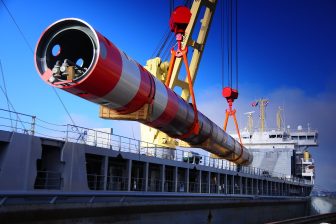
Titan to bunker UECC’s fleet with LBM at Zeebrugge
United European Car Carriers (UECC) and Titan Clean Fuels (Titan) will collaborate on a series of liquefied biomethane (LBM) bunkering operations at the Port of Zeebrugge.
This month, Titan will supply ISCC-EU certified mass balanced LBM, also known as bio-LNG, to all of UECC’s LNG dual-fuel car carriers. These vessels will use 100 per cent LBM as part of UECC’s “Green Gas Month” initiative, which supports their wider “Sail for Change” sustainability program. Three of the car carriers are also equipped with battery hybrid technology, further enhancing their environmental performance.
The use of LBM, derived from biomethane waste feedstock, significantly reduces greenhouse gas (GHG) emissions. These emissions reductions will be documented in a CO2 registry established by UECC in January 2024. This transparent and independently verified system allows UECC to transfer the environmental benefits of clean fuel use to their customers throughout the supply chain. The company expects the Welll-to-Wake emissions reduction during the ‘Green Gas Month’ alone to exceed 8,000 metric tonnes of CO2.
“Through the use of biomethane, ‘Green Gas Month’, and ‘Sail for Change’ more broadly, we are providing our customers with a great springboard to further their own decarbonisation strategies,” said Daniel Gent, Energy & Sustainability Manager at UECC. “With progressive automakers focusing on cleaner cars, we expect them to want to reduce their scope three emissions and ship those cars sustainably – which is what we can deliver in collaboration with Titan right now.”
Gent added, “Tightening environmental regulations and emissions levies like the EU Emissions Trading System are also increasingly boosting the commercial rationale for using clean shipping services. The use of LBM as a marine fuel reduces UECC’s, and our customer’s exposure to the costs of emitting within the EU ETS, which will continue to ramp up quickly over the coming years.”
Flip Dankelman, Trader at Titan, added, “the mass balanced LBM via Fluxys’ LNG Terminal in Zeebrugge is a practical, realistic and cost-competitive way to use clean marine fuels today. And the UECC team has valued the flexibility that our fleet of strategically located LNG bunker vessels can offer.”
This successful LBM transaction reinforces the viability of LNG as a pathway to achieving net-zero GHG emissions in shipping. LNG offers a safe and cleaner starting point with existing infrastructure.
LBM, unlike other alternative fuels, is already being implemented at scale. Depending on the feedstock, LBM can achieve net-zero GHG emissions or even become net-negative when considering avoided waste emissions. The next stage is the introduction of e-methane produced using renewable electricity and electrolysis. All these fuels can be blended and used in existing LNG infrastructure without modification.
This clean fuel supply agreement and milestone on the LNG pathway is particularly timely as the European Union’s FuelEU Maritime regulation is set to come into effect on January 1, 2025. This regulation incentivizes the use of renewable fuels, particularly those not derived from biological sources like e-methane. The regulation applies to vessels exceeding 5,000 GT, with 100 per cent of emissions considered within the EU and 50 per cent if one port of call falls outside the EU.
You just read one of our premium articles free of charge
Want full access? Take advantage of our exclusive offer




